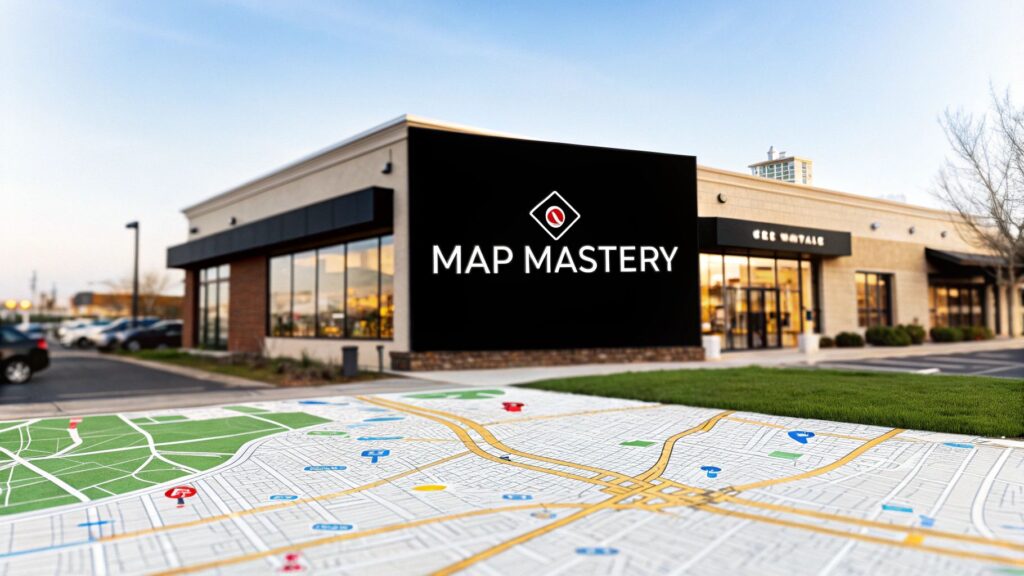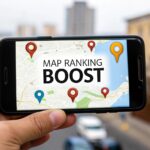Want to climb the Google Maps rankings? The most important thing is getting your Google Business Profile (GBP) in perfect shape. A complete profile with the right categories, a good description, and quality photos tells Google you're a real, relevant business for local searches.
Learning how to increase Google Maps ranking starts with this foundation. It’s the biggest signal you can send to the algorithm.
Nail Your Google Business Profile Foundation
Before diving into complex SEO tactics, let’s get the basics right. Your Google Business Profile is your digital storefront. For many customers, it's their first impression of you. A complete and accurate profile is a must-have for ranking well.
This isn’t a secret trick. It's about showing Google you're the real deal.
Choose the Perfect Business Categories
This is a big one. Your primary category tells Google exactly what you do. Don't be vague. If you're a roofer specializing in metal roofs, your primary category should be "Metal Roofing Contractor," not just "Roofer."
After setting your primary category, add secondary ones for other services. That same roofer might also offer "Gutter Cleaning Service" and "Roof Inspection." This helps you show up in more searches.
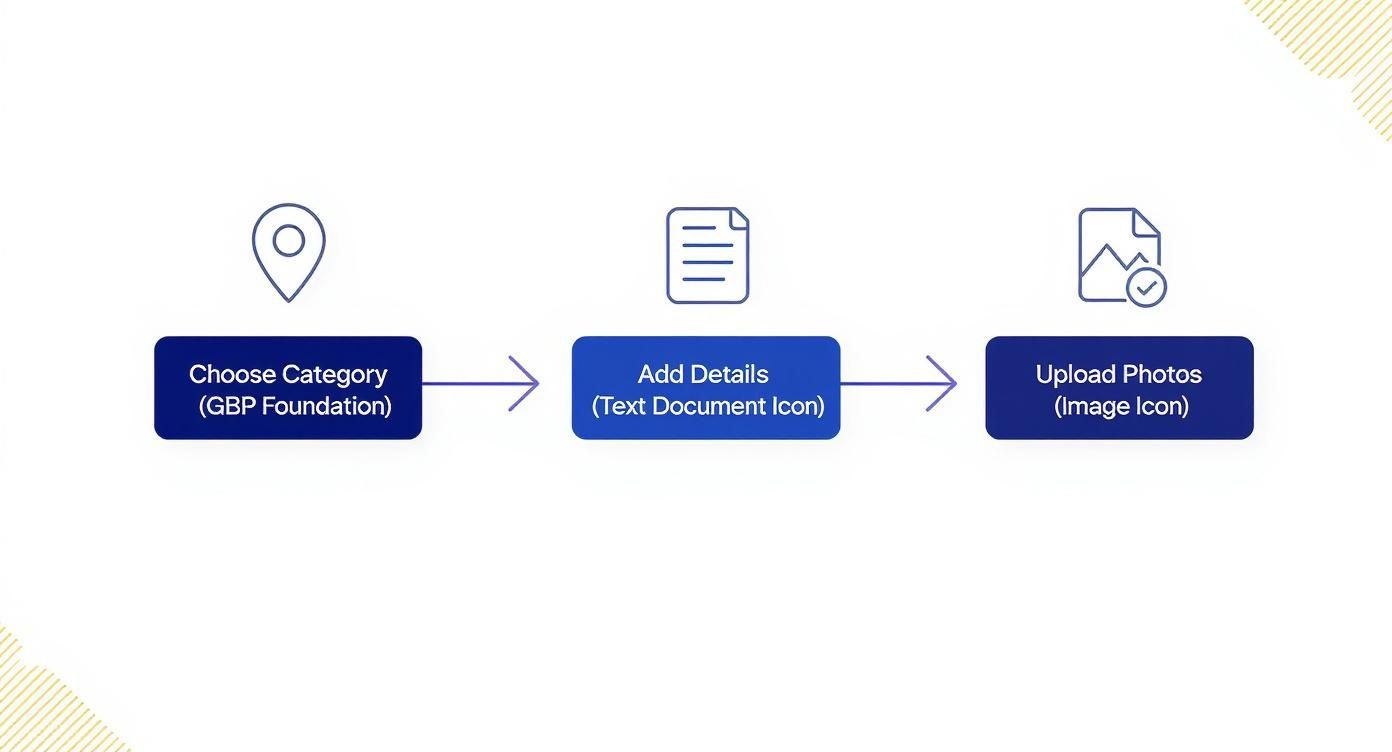
In Short: Nailing your categories, filling out all details, and adding photos are the core of a strong GBP.
Fill Out Every Single Section of Your Profile
Many businesses leave parts of their profile blank. Every empty field is a missed opportunity for a competitor to outrank you.
A complete Google Business Profile isn't just for show. It's a direct signal to Google's algorithm that you're an active business worthy of a top spot. Make sure you fill out every detail.
Google Business Profile Core Optimization Checklist
Here’s a quick list of the essentials. Think of this as your minimum for ranking success.
| GBP Feature | Why It Matters for Ranking | Action Item |
|---|---|---|
| Business NAP | Name, Address, Phone. Consistency is a huge trust signal for Google. | Ensure your NAP is 100% identical everywhere online. |
| Categories | The primary category is a top ranking factor; secondary ones broaden reach. | Pick the most specific primary category, then add all relevant secondary ones. |
| Services & Products | Helps you rank for specific, long-tail searches (e.g., "emergency AC repair"). | List every service with brief, keyword-friendly descriptions. |
| Business Description | Your chance to include relevant keywords and explain what you do. | Write a compelling 750-character summary of your business. |
| Photos & Videos | Increases engagement and proves you're a real, active business. | Upload high-quality, recent photos of your work, team, and location. |
| Hours of Operation | Accuracy builds customer trust and prevents negative experiences. | Keep your regular and holiday hours updated at all times. |
Completing this checklist puts you far ahead of lazy competitors. If you need a full walkthrough, check out this guide on how to get a Google Business listing.
Getting these foundational pieces right is the most critical first step and the cornerstone of any effective local SEO services for small businesses.
Turn Customer Reviews into a Ranking Superpower
If you want to rank on Google Maps, you have to get serious about reviews. They are powerful social proof for a local business. They tell both Google and customers that you’re trustworthy.
Trying to rank without a steady stream of happy customers is a losing battle. A constant flow of positive feedback is a direct signal to Google’s algorithm that you’re a top choice in your area.
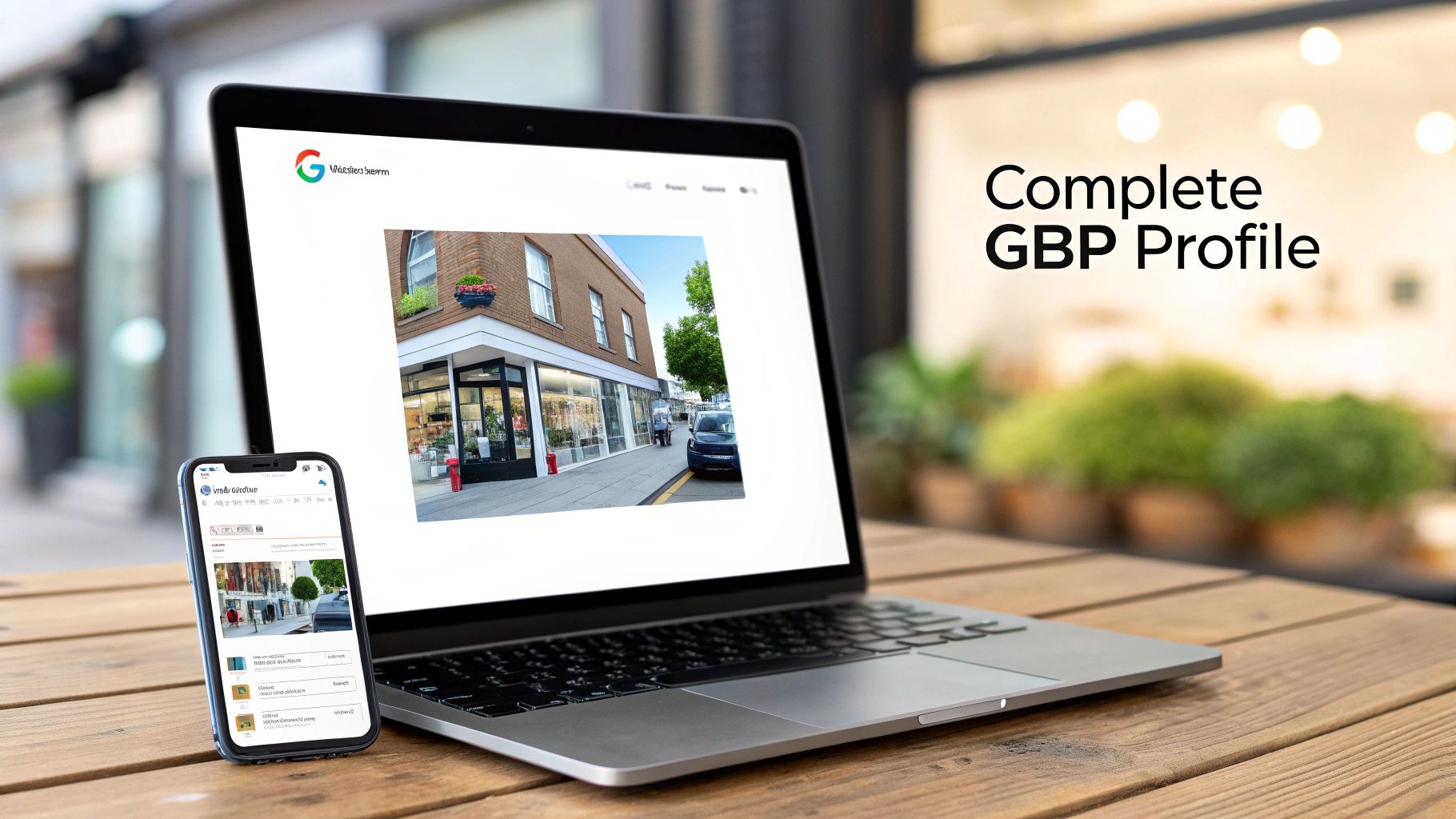
Why Reviews Are a Major Ranking Factor
Think about it from Google's perspective. Its job is to provide the best, most trustworthy result. What’s a better indicator of trust than customer experiences? A business with 150 four-and-a-half-star reviews feels like a safer bet than one with only three reviews.
Data shows that high Google ratings and review quantity are major ranking factors. The message is clear: Google heavily favors businesses with more positive community feedback.
How to Get More Google Reviews Without Being Pushy
Asking for reviews can feel awkward, but it doesn't have to be. The key is to make it simple for the customer and ask at the right moment.
Here are a few tactics that work:
- Ask at the right time. The best time to ask is right after a customer gives you a compliment. You can say, "I'm so glad you love it! If you have a second, sharing that on Google would mean the world to us."
- Use a direct link. Google gives you a short link that goes straight to your review form. Put that link in your email signature, on invoices, and in follow-up texts.
- Send a quick follow-up. A day or two after a job, a simple email or text asking for feedback goes a long way. Keep it short and personal.
For example, a service business can set up an automated text that goes out an hour after a job is marked complete. It’s an easy system for everyone.
Why You Must Respond to Every Single Review
Getting reviews is only half the job. You have to respond to them—every single one. This shows potential customers that you're engaged and care. More importantly, it signals to Google that you're actively managing your profile.
In Short: Responding to reviews, both good and bad, is one of the easiest ways to build trust.
Make it a habit to respond to all new reviews within 24-48 hours.
How to Handle Good Reviews:
When someone leaves a great review, thank them by name. Reference something specific they mentioned to make the response feel genuine.
Example: "Thanks so much, Sarah! We're thrilled you loved the new patio. It was a pleasure bringing your backyard vision to life!"
How to Handle Bad Reviews:
A negative review is an opportunity. A professional response can win over new customers who see how well you handle problems.
- Acknowledge and Apologize. Validate their feelings and say you're sorry they had a bad experience.
- Don't Argue. Avoid getting defensive. Taking the high road always looks better.
- Take It Offline. Provide a direct contact—a name, email, or phone number—to resolve the issue privately.
Learning a few effective strategies for responding to customer complaints can turn tricky situations into moments that strengthen your reputation.
Win the Proximity and Relevance Game
You can't move your shop closer to every customer. But you can send powerful signals to Google that you're the most relevant choice in your service area. When you're trying to figure out how to increase google maps ranking, remember Google's goal: find the best result, not just the closest one.
This is where proximity and relevance come into play. Proximity is how close your business is to the searcher. Relevance is how well your profile matches what they're looking for.

The good news is you have total control over your relevance signals. This is how you outrank competitors, even if they're a block closer.
Weave Local Keywords into Your Profile
One of the easiest ways to show relevance is by using local keywords in your GBP. Think like a customer. What are they typing into the search bar? A homeowner in Denver isn’t just searching for "plumber." They're looking for an "emergency plumber in Capitol Hill."
Work these location-specific phrases into your profile:
- Business Description: Talk about the neighborhoods and cities you serve.
- Services: Instead of "AC Repair," create a service called "AC Repair in Scottsdale."
- Google Posts: When you share updates, mention the local areas. "Just finished a kitchen remodel in the Oak Lawn neighborhood!"
- Review Responses: If a customer from a target area leaves a review, reply with, "Thanks, Mark! We're glad we could help you out over in the Lakewood area."
This builds a powerful connection between your business and the areas you want to own.
The Power of Localized Service Pages
Your website is a huge piece of the puzzle. Creating dedicated pages on your site for each service and each location is a game-changer.
A roofer in Dallas who also works in Plano should have separate pages like:
- Roof Repair in Dallas
- Roof Replacement in Plano
Each page needs unique content focused on that service in that place. This proves to Google you have authority in those towns, which feeds back into your Google Maps ranking.
How Google's AI Balances It All
Proximity is still a huge factor, but Google's AI now gives just as much weight to relevance. A business that perfectly matches a user's needs can leapfrog a closer competitor. The big takeaway is that Google's results change based on who is searching and where they are. You can learn more about the AI impact on Google Business Profile rankings.
In Short: Proving you're the most relevant answer to a local search can overcome a distance disadvantage.
Strengthen Your Authority with Citations and Links
What you do on your Google Business Profile is only half the battle. To really climb the local search rankings, you need to build a solid reputation across the web. Think of it like a real-world referral. The more credible sources that vouch for you, the more Google will trust you.
This is where citations and local links come in. They prove your business is a real, respected part of the local community. Getting this right is a huge piece of learning how to increase google maps ranking.
Nail Your NAP Consistency with Citations
What is a citation? It's any mention of your business's Name, Address, and Phone number (your NAP) online. You find these on directories like Yelp, industry sites like Angi, or your local chamber of commerce website.
Google crawls the web looking for your NAP. When it finds your information listed identically everywhere, it sends a powerful signal of trust. Inconsistencies create confusion and can hurt your ranking. The goal is 100% NAP consistency.
Here's where to focus first:
- Data Aggregators: Services like BrightLocal and Semrush push your info to hundreds of directories, saving you time.
- The Big Names: You must be on Yelp, Apple Maps, and Facebook.
- Niche-Specific Sites: If you're a contractor, be on Houzz. If you run a restaurant, be on TripAdvisor. Go where your customers are.
In Short: A perfectly consistent NAP across high-quality online directories is the foundation of your off-page local SEO.
Earn Those High-Impact Local Links
Citations confirm your business exists. Local links prove your business matters. A backlink is a clickable link from one website to yours. When a respected local website links to you, it tells Google, "Pay attention to these guys. They're important."
Quality matters more than quantity. A link from the local newspaper is worth more than a link from a spammy directory.
Here are a few ways to earn local links:
- Sponsor a Local Event: Sponsoring a 5K run or a high school team often gets you a link from the event's website.
- Partner with Other Locals: Team up with a non-competing business. A painter and a roofer could write a guide together and link to each other.
- Join the Chamber of Commerce: This is one of the easiest, highest-authority links you can get.
- Create Helpful Local Content: Write blog posts about local topics, like "The 5 Best Hiking Trails in [Your Town]." Local bloggers and news sites love to link to these resources.
These efforts are the backbone of any serious local SEO campaign, especially for service businesses. We dive deeper into these tactics in our guide on SEO for contractors.
Use Your Website to Supercharge Your Local SEO
Think of your GBP and your website as a tag team. They're more powerful together. Your website sends signals to Google that can either boost your Google Maps ranking or drag it down.
Your website is home base. It’s where you can prove you’re the real deal in your local area.
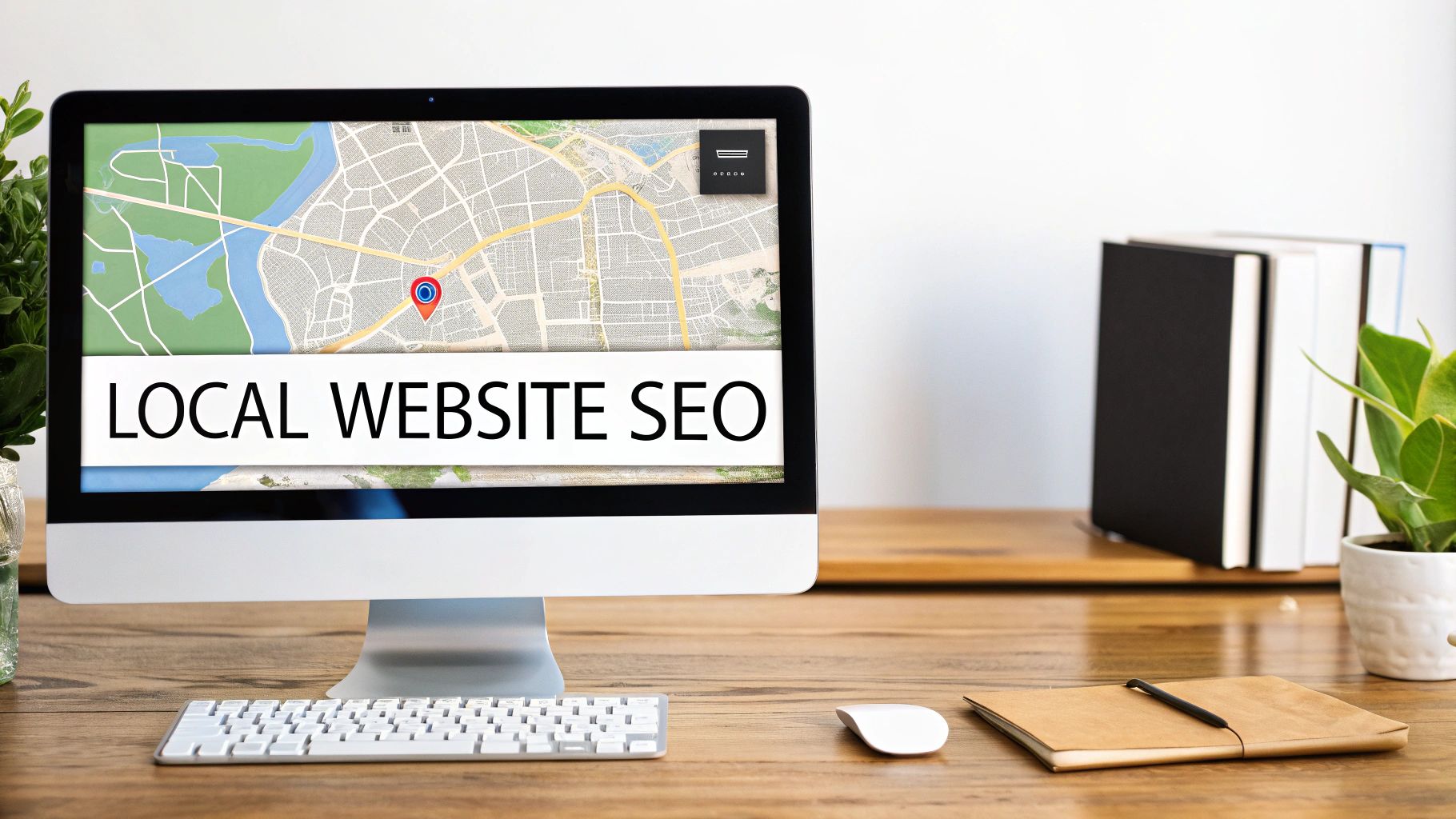
Create Specific Location and Service Pages
One of the most effective things you can do is build dedicated pages on your website for each service in each location. Generic pages don’t work anymore.
Imagine you're a painter in Chicago who also works in Evanston. A smart website would have pages like:
- Interior Painting in Chicago
- Exterior Painting in Evanston
Each page needs unique content. Mention local landmarks or talk about common types of homes in that area. This shows Google you have a real, boots-on-the-ground presence.
Make Your Contact Information Obvious
Consistency is everything. The Name, Address, and Phone number (NAP) on your website must exactly match what's on your GBP.
A simple way to do this is to put your NAP in the footer of every page on your site.
Also, embed a Google Map on your contact page. It’s a simple move that creates a direct link between your website and your Google Maps listing.
Write Helpful, Hyper-Local Content
Think like a local customer. What problems do they have that only a local pro can solve? Creating blog posts that answer these questions is a goldmine for relevance.
Here are a few examples:
- An Austin roofer could write a guide on "Choosing Roofing Material for Texas Heat."
- A Minneapolis landscaper might post about "How to Winterize Your Sprinkler System."
- A Miami pest control company could write about "Common South Florida Pests in Hurricane Season."
This type of content pulls in local customers and screams "local authority" to Google. This directly helps your visibility on Google Maps.
People Also Ask
Let's tackle some common questions users ask about ranking on Google Maps.
How do I get my business to the top of Google Maps?
To get to the top, you need to fully optimize your Google Business Profile (GBP), get a steady stream of positive reviews, and ensure your business name, address, and phone number (NAP) are consistent across the web. Building a strong local presence on your own website with location-specific pages also helps significantly.
Does website SEO affect Google Maps?
Absolutely. Google uses signals from your website—like local keywords and location-specific pages—to verify your business's relevance and authority. A well-optimized website with strong local SEO directly supports and boosts your Google Maps ranking.
Why is my business not showing up on Google Maps?
There are a few common reasons. Your Google Business Profile might be incomplete or unverified. You could have inconsistent NAP information across different online directories. Or, your business may be in a very competitive market and location, making it harder to rank without strong optimization and positive reviews.
Keep Score and Tackle a Few Common Headaches
You've done the work, but how do you know if it’s working? You can't just set it and forget it. It's time to analyze your results and learn how to handle common problems.
Dive into Your Google Business Profile Performance Data
Google gives you a free dashboard called Performance (formerly Insights). It's a goldmine of data.
Keep an eye on these key numbers:
- Queries: The exact search terms people used to find you.
- How customers search for you: "Direct" searches (your name) vs. "Discovery" searches (a service like "plumber near me"). More Discovery searches means your SEO is working.
- Customer actions: How many people clicked your website, asked for directions, or called you from your profile.
Check these numbers monthly to see what’s working.
Troubleshooting the Tough Stuff
Sometimes things go wrong. Two common problems are profile suspensions and spammy reviews.
If your profile gets suspended, don't panic. First, carefully review Google's guidelines. The issue is often something small, like a keyword in your business name or an incorrect address. Fix the issue, then submit a reinstatement request. Be ready to provide proof like a business license or utility bill.
For fake negative reviews, you can flag them for removal from your GBP dashboard. Briefly explain why you believe the review is fake. It's not a guarantee, but it's the official process.
Ready to stop guessing and start ranking? Clicks Geek specializes in data-driven local SEO that gets real results for businesses just like yours. Let our team of experts build a strategy that puts you at the top of the map. Learn more about our SEO services.
Is Your Business Ranking in Google Maps?
Turn Google Maps into a Lead Engine w/ Clicks Geek’s AI-powered local SEO. 3,000+ clients served. Our proprietary, fully done-for-you Maps SEO system handles everything—keyword targeting, local optimization, content, reviews, and ranking strategy—automatically.


